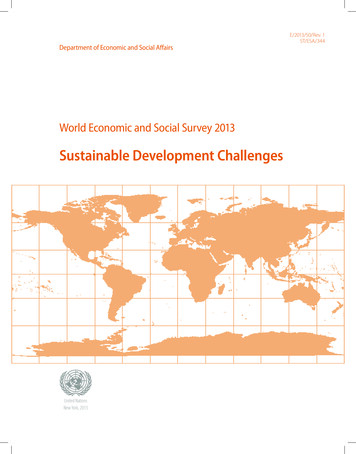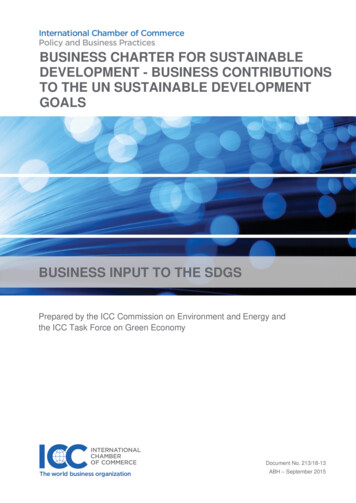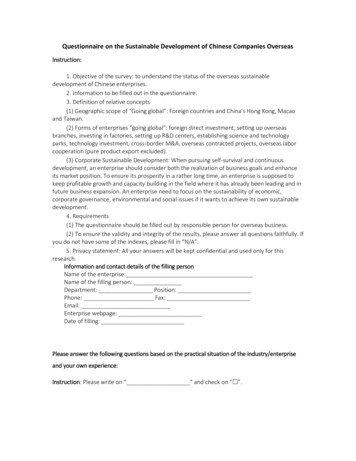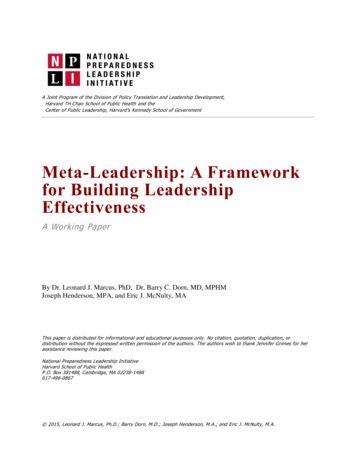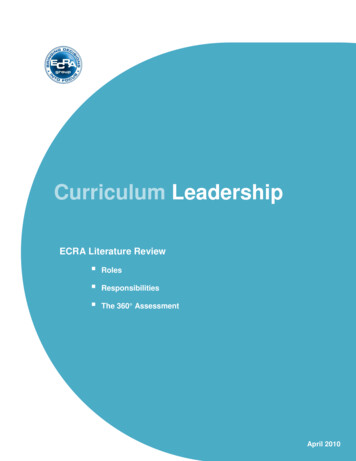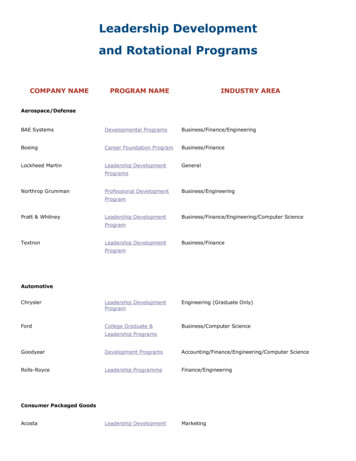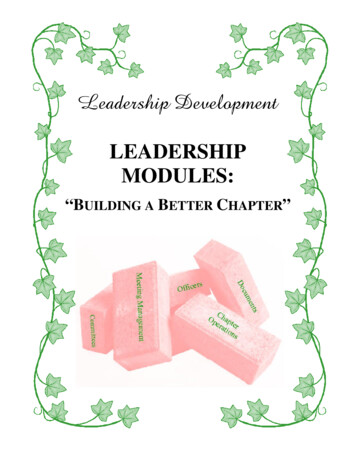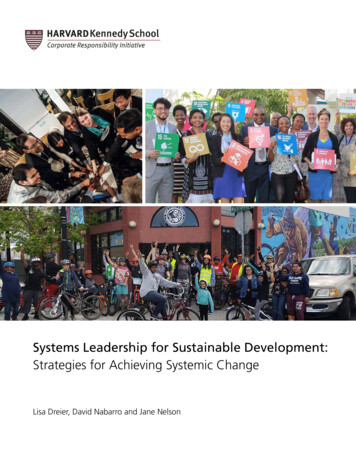
Transcription
D I S C U S S I O N PA P E RSystems Leadership for Sustainable Development:Strategies for Achieving Systemic ChangeLisa Dreier, David Nabarro and Jane Nelson
Systems Leadership for SustainableDevelopment: Strategies for AchievingSystemic ChangeWritten by Lisa Dreier, David Nabarro and Jane NelsonCover photos: World Economic Forum New Vision forAgriculture Initiative (upper left), Scaling Up NutritionMovement (upper right), and Rich City Rides (below).Designed by Alison Beanland 2019 by the CR Initiative at the Harvard Kennedy School
ContentsExecutive Summary4Preface: A Tool for our Times6I.Systems Leadership: An emerging approach for tackling complex challenges7II.The Emergence of the Systems Leadership Concept9III.Defining Systems Leadership13IV.The CLEAR Framework for Leading Systems Change17V.The Journey of Systems Leadership: The “Aha!” Moments28VI.Mindsets and Behaviors of Individual Systems Leaders35VII.Mainstreaming Systems Leadership: The Way Forward37Annexes1.Frameworks for Systems Leadership and Systems Change392.CLEAR Framework Self-Assessment Questions for Systems Leadership Initiatives433.List of Reviewers45Endnotes46SYSTEMS LEADERSHIP FOR SUSTAINABLE DEVELOPMENT 3
Executive SummaryAddressing complex challenges through systems changeThe 2030 Sustainable Development Agenda includes 17 inter-related Sustainable Development Goals (SDGs), eachrepresenting complex systems – such as climate, food, health, cities – with myriad stakeholders. Achieving progresson this agenda requires a departure from traditional top-down, hierarchical and linear approaches to implementingchange. Instead it requires innovative and adaptive approaches that engage broad networks of diverse stakeholdersto advance progress toward a shared vision for systemic change. This approach is called Systems Leadership.Systems Leadership: A tool for our timesSystems Leadership is a set of skills and capacities that anyindividual or organization can use to catalyze, enable andsupport the process of systems-level change. It is comprisedof three interconnected elements:1The Individual: The skills of collaborativeleadership to enable learning, trust-buildingand empowered action among stakeholderswho share a common goal2The Community: The tactics of coalition buildingand advocacy to develop alignment and mobilizeaction among stakeholders in the system, bothwithin and between organizations3The System: An understanding of the complexsystems shaping the challenge to be addressedThe Key Elements of Systems LeadershipTHE SYSTEMComplexSystemsInsightTHMMUNE COITYCoalitionbuilding adershipSkillsTHLE IND I V I D UA4 SYSTEMS LEADERSHIP FOR SUSTAINABLE DEVELOPMENTThe CLEAR Framework for LeadingSystems ChangeThe CLEAR Framework for Leading Systems Changedescribes five key elements of the systems change process.These are not necessarily sequential – they may overlap orrepeat in cycles throughout the course of an initiative.1. Convene and CommitKey stakeholders engage in moderated dialogue to addressa complex issue of mutual concern. They define sharedinterests and goals, and commit to working together innew ways to create systemic change.2. Look and LearnThrough system mapping, stakeholders jointly build ashared understanding of the components, actors, dynamics,and influences that create the system and its currentoutcomes, generating new insights and ideas.3. Engage and EnergizeDiverse stakeholders are engaged through continuouscommunication to build trust, commitment, innovation andcollaboration. Inspiration, incentives and milestones helpdrive progress and maintain momentum.4. Act with AccountabilityShared goals and principles set the direction of the initiative,while measurement frameworks help track progress.Coordination and governance structures can be developedas initiatives mature.5. Review and ReviseStakeholders review progress regularly and adapt theinitiative strategy accordingly. Adopting an agile, flexible,innovative and learning-centered approach allows forevolution and experimentation.
EXECUTIVE SUMMARYThe Journey of System Leadership: The “Aha!” MomentsParticipants in systems-change initiatives often describe the experience as acollective “journey” of discovery that evolves over time. Many stakeholdersencounter similar experiences, which often crystallize in an “Aha! Moment” –a new insight that describes the dynamics at a given moment in the journey,such as those described below.1 “No one is in control”No single entity has authorityover the entire system.4 “That’s our North Star”The group agrees on ashared goal or vision toguide and align theirefforts.7 “I can make a difference”One person, organizationor small group can havesignificant impact.2 “It’s up to us”3 “Everything is Connected”Stakeholders recognize acollective responsibilityto address the challengethemselves.5 “To Go Far, Go Together”Engaging and securing buy-infrom a wide array of stakeholdersis essential.8 “We need coordination”As the initiative grows,a coordinating team orSecretariat is often needed.Collective mapping andlearning about the systemgenerates new insights.6 “We’ll find a way”Challenges and setbacks can spurinnovation and collaboration.9 “Wow! Change is happening”Demonstrating and celebratingprogress helps maintainmomentum.10 “We’re in it together, for the long haul”Reaffirming commitment and evolving to meet changingneeds enables long-term success.Mainstreaming Systems LeadershipThe Systems Leadership approach is still in an early stageof development. Greater alignment and collaboration isneeded among relevant experts and practitioners to enablebroader access to and adoption of the approach. Additionalinvestments and partners are needed to research andevaluate existing initiatives; disseminate insights on goodpractices; expand capacity-building training and tools; andstrengthen leadership support.While Systems Leadership is not yet widely practiced, it offersa potentially valuable tool for addressing the complexity,dynamism and scale of the multi-dimensional challengesunderlying the SDGs. As such, it shows great promise asa tool for advancing the 2030 Agenda for SustainableDevelopment.SYSTEMS LEADERSHIP FOR SUSTAINABLE DEVELOPMENT 5
Preface: A Tool for our TimesThe complex and inter-connected issues at the heart of the Sustainable Development Goals (SDGs) requireinnovative approaches for mobilizing widespread and meaningful action. One of these approaches is describedas Systems Leadership.The Systems Leadership approach is well-suited to complexchallenges that require collective action, where no singleentity is in control. It involves building and mobilizingalliances of diverse stakeholders around a shared vision forsystemic change, empowering widespread collaboration,innovation and action; and enabling mutual accountabilityfor progress to shift systems towards sustainability.1 SystemsLeaders, which can include both individuals and institutions,serve as catalysts and enablers of this process – a rolerequiring optimism, flexibility and endurance, along with theability to understand and empower stakeholders with verydifferent viewpoints and incentives.While the concept of Systems Leadership makes intuitivesense to many stakeholders, it is not yet widely embracedand practiced. Mainstreaming its application will require abroader and more coordinated effort to develop research,share knowledge and build capacity. Platforms forexchanging knowledge and experiences among SystemsLeadership practitioners are needed to share and acceleratelearning.This paper contributes toward that broader goal by offeringconcepts, examples and tools of Systems Leadershipto professionals from multiple sectors who are workingto advance sustainable development. It seeks to link andsynthesize existing experiences in diverse sectors andgeographies. It is informed by the practical experiencesof the authors in building a variety of multi-stakeholdercoalitions at global, regional and national level across variedsectors including health, nutrition, agriculture, environmentand energy. It also draws on interviews, case examplesand literature reviews, suggesting ways in which SystemsLeadership approaches can usefully be applied to complexchallenges in sustainable development. The paper buildsupon previous work on the topic, drawing extensively fromexisting expertise and research to provide additional insightsand resources for practitioners and leaders.6 SYSTEMS LEADERSHIP FOR SUSTAINABLE DEVELOPMENTWe are indebted to the experts and leaders who contributedtheir time and perspectives to shape the perspectives sharedin this paper, including John Atkinson, Banny Banerjee,Jennifer Dunne, Hal Hamilton, John Kania, Ian Randall,Darcy Riddell, Peter Senge, Linda Booth Sweeney, DominicWaughray, and Darcy Winslow. These leading experts andpractitioners are among a growing number of advisors,initiatives and programs that are involved in developing andapplying Systems Leadership and systems change strategies.This paper does not provide a comprehensive mappingof the field, instead seeking to present highlights andsyntheses. We apologize for any omissions and look forwardto continued dialogue and collaboration with those workingto develop and apply systems-oriented approaches.The practice of Systems Leadership is constantly evolving.Many of its core elements are ready for use by individuals,institutions and communities. As a growing number ofindividuals and institutions apply and further develop thisapproach, they will generate new insights and capacities toadvance the systems-level changes that are essential for asustainable future.We thank the Harvard Kennedy School’s CorporateResponsibility Initiative for supporting and publishing thispaper, as part of its broader work to advance constructivestrategies for multi-stakeholder contributions to sustainabledevelopment.Lisa Dreier David Nabarro Jane Nelson
I Systems Leadership: An emerging approachfor tackling complex challengesWhat is Systems Leadership?Systems Leadership is a set of skills and capacities that anyindividual or organization can use to catalyze, enable andsupport the process of systems-level change. To illustrate howit can work, consider two very different examples.In 2015, the landmark Paris Agreement committed 195countries to a framework for action on climate change– including specific targets for reducing greenhouse gasemissions, support for climate mitigation and adaptation,and a monitoring and reporting framework. Advocacy andnegotiations leading up to the agreement engaged thousandsof organizations including governments, industry, civilsociety, international organizations, academia and research,faith organizations and indigenous communities. A numberof individual leaders within these stakeholder networksplayed crucial roles in building alignment, mobilizing actionand securing commitment. The most visible was ChristianaFigueres, who led this historic process as Executive Secretary ofthe UN Framework on Climate Change (UNFCC), establishingwhat many characterized as a new model of collaborativediplomacy – engaging a broad diversity of stakeholders injointly developing solutions and commitments.Across the world in the city of Richmond, California, agrassroots organization called Rich City Rides set outto address the inter-locking challenges of poverty,chronic disease and environmental degradation whichdisproportionately affect the city’s communities of color.They conceived a vision for developing Richmond as a bicyclefriendly community, using cycling to improve health, providesustainable transportation, generate job opportunities, andstrengthen the community’s social fabric. They establisheda bike shop, working with local youth to reclaim and repairover 1,000 bicycles, building job skills and economic assetsas well as sustainable, low-cost transport. They organizedbicycle outings, camping trips and park cleanups to engagefamilies in healthy exercise and nature appreciation. In theprocess the founder of Rich City Rides, Najari Smith, engagedlocal community organizations, city and regional government,philanthropists and industry to help support and implementthese innovative programs.What do Christiana Figueres and Najari Smith have incommon? On the face of it they are very different – onea diplomat from Latin America; the other a communityorganizer from California. One works at the highest levelsof global leadership, the other at the most local communitylevel. One is the daughter of a president who studied abroadand earned a graduate degree; the other grew up in Brooklyn,graduating from a public high school and college.But a closer look reveals important similarities. Both set outto address a complex problem which involved multipledimensions and required multi-faceted solutions. Both workedwith diverse stakeholders to develop an ambitious and holisticvision for change and leveraged the power of networks tomobilize action and commitment toward that goal. Both tooka collaborative approach, engaging and empowering relevantstakeholders rather than trying to control or direct them.These similarities illustrate the concept of Systems Leadership,a relatively new term for the leadership skills, tactics andqualities that can be effective in addressing complex, systemicchallenges. Systems Leadership draws upon familiar skills –such as subject expertise, strategy development, programmanagement, coalition-building, and collaboration – manyof which have been applied by advocacy and communitydevelopment leaders for decades. However SystemsLeadership combines these skills in a new way with the explicitgoal of creating change on complex, systemic issues. It is thecombination of knowledge, skills and mindset, applied tocreate systemic transformation, that defines a Systems Leader.Why is this important? Because the challenges facing ourlocal and global communities are increasingly complex andinterconnected, and they demand this kind of approach.Whether it’s the intersection of poverty, health andenvironment in urban America, or the global challenge ofclimate change that affects everything from food to healthto urban planning, today’s problems are complex andrequire coordination among many stakeholders. No singleorganization can solve these complex challenges – instead,diverse stakeholders must come together to develop a sharedapproach. That requires coordination as well as vision, trustbuilding and innovation. It requires Systems Leadership.SYSTEMS LEADERSHIP FOR SUSTAINABLE DEVELOPMENT 7
I SYSTEMS LEADERSHIP: AN EMERGING APPROACH FOR TACKLING COMPLEX CHALLENGESThe need for Systems Leadership to address complex global challengesThe Systems Leadership approach is especially relevant tothe complex global challenges facing us today – such aspoverty, hunger, human health, environmental degradationand violent conflict. The international community is seekingnew approaches to these types of challenges as it works toachieve the Sustainable Development Goals (SDGs). Adoptedin 2015 by 193 countries as part of the historic 2030 Agendafor Sustainable Development, the 17 SDGs define ambitioustargets to improve global sustainability, health, economicdevelopment and equality. The architects of the SDGsrecognized that the goals were closely inter-linked and calledfor holistic, synergistic and people-centered approaches –engaging all stakeholders – to achieve them.Progress on such global challenges requires a collectiveembrace of complexity. It requires the commitment ofindividual people and organizations joining together totake collective action through large networks and coalitions,in order to create impact and systemic change at scale.It requires new and innovative approaches that engagebroad networks of diverse stakeholders, harnessing theircomplementary capacities to advance progress towarda shared goal. It requires strategies that are emergent,adaptive and flexible, because complex systems are alwayschanging.This necessitates a departure from traditional, hierarchicalapproaches to implementing change. More top-down formsof leadership are based on authority and control, whichworks well when the scope is limited to one organization’ssphere of influence. For example, a company can change itsproduct line or supply chain to reduce its carbon footprintwith a simple order from the CEO. However the top-downapproach will not enable that company to solve globalclimate change. To tackle that systemic challenge, thecompany must work with many other stakeholders – suchas policymakers, technology providers, civil society andresearch institutions – to mobilize a broader impact with agoal of achieving system-wide change. Engaging in suchcollaboration and alliance-building is often a new andunfamiliar approach.8 SYSTEMS LEADERSHIP FOR SUSTAINABLE DEVELOPMENTThe past decade has seen an evolving series of strategiesfor advancing equitable and sustainable development.The earliest approaches focused on efforts by individualorganizations – governments, nonprofits and internationalorganizations ran their own programs, while companiesdeveloped socially beneficial business or philanthropicactivities under the banners of corporate socialresponsibility (CSR), creating shared value and inclusivebusiness. However many of these approaches wereconstrained in their systemic impact. Over time, manycompanies worked to deploy their business strategies incollaboration with nonprofits, governments, and otherorganizations through public-private partnerships, whichstrengthened social impact but were often difficult to scale.To drive large-scale change, stakeholders are increasinglyforming broad multi-stakeholder coalitions, involving dozensor hundreds of organizations. FSG described this as thecollective impact2 approach and it remains highly effectivein building large-scale alliances to tackle specific challenges.This approach draws heavily on the coalition-building andadvocacy approaches developed over many decades by civilsociety and social movements. Building on this rich history,the Systems Leadership approach emerged as a way tocreate transformational systemic change, by mobilizing andempowering networks of diverse stakeholders to achieve acommon goal through widespread action and innovation.Systems Leadership is designed to support the collectivejourney of systems change. It helps foster the innovation,insight, trust and collaboration that aids the transformation ofindividual systems components and systems-wide dynamics.It offers techniques and tools that catalyze, enable andaccelerate multi-level, long-term transformation of systems.It enables stakeholders to tackle issues whose complexityand scope has defied resolution through other means. Itcan build the adaptive capacity of a system, enabling it tobetter respond to future challenges in addition to improvingoutcomes for today. As a result, it can be a valuable tool tosupport efforts to realize the 2030 Agenda for SustainableDevelopment.
II The Emergence of the Systems LeadershipConceptThe term “Systems Leadership” surfaced during the past decade and has attracted increasing interest as diversestakeholders seek new approaches to address complex, systemic challenges. However the concept of SystemsLeadership has deeper roots, drawing from decades of academic research and practitioner experience in the interlinked fields of systems dynamics, organizational behavior, and leadership for collective impact. Numerous individualsand institutions have played leadership roles in these different fields of endeavor. The following overview, while notexhaustive, presents select highlights.From System Dynamics to Societal ChallengesStarting in the 1940s, biologist Ludwig von Bertalanffydeveloped systems theory3 to describe the nature andbehavior of systems. Defining systems as a set of interacting,inter-related units, the theory stated that the behavior andoutputs of the system are driven by the interaction of itscomponents. In the ensuing years, complexity scienceemerged as an inter-disciplinary approach to understandingcomplex systems, drawing from systems theory, cybernetics,ecology and biology, sociology, mathematics, and otherdisciplines, led by the Santa Fe Institute and a broad networkof academics. At MIT in the 1960s, pioneering computerengineer Jay Forrester founded the system dynamicsapproach4 to analyze, model and simulate the non-linearbehavior of complex systems. This approach recognized thatthe interactions among elements of a system were just asimportant as the elements themselves in determining thebehavior of a system. Initially applied to industrial systems, theapproach evolved to analyze broader societal challenges suchas urban development and environmental sustainability.Fellow MIT scientists Donella Meadows, Dennis Meadows,Jorgen Randers, and William Behrens III worked with Forresterto create a global model projecting trends in population,consumption and environmental resources, publishingthe influential Limits to Growth study in 1972 that helpedcatalyze the global environmental movement. Over theensuing decades, Donella Meadows became a leadingexpert in describing the concept of complex, evolving, selfperpetuating systems – and the unforeseen consequencesthat can result from intervening to change them. Her bookThinking in Systems5 presents her key insights in concise andaccessible form.Drawing from work with the MIT System Dynamics group,management professor Peter Senge focused on thebehavioral aspects of systems change to develop newapproaches to business and organizational leadership.His bestselling book, The Fifth Discipline, described howcompanies can strengthen innovation, resilience andcompetitiveness by becoming “learning organizations” –embracing aspirational goals, reflective conversation andan understanding of complexity. In 2007 Senge called for anew type of cross-sector, multi-stakeholder collaborationfor systemic change, uniting conceptual, relational andaction-driven approaches, for which there was “no realprecedent.”6 Canadian academics Frances Westley andBrenda Zimmerman applied complexity theory to socialinnovation, emphasizing the systemic impact of changingthe relationships between stakeholders.7Building on this work, MIT economist Otto Scharmer soughtto understand the deeper drivers of effective system change,concluding that the quality of awareness among people in asystem drives the quality of results produced by that system.Scharmer developed “Theory U,” a framework for creatingsystems change through improved awareness, insight andco-creation.8 He founded the Presencing Institute to sharethe approach, catalyzing a virtual platform for practitionerscalled u.lab which has reached over 100,000 people in185 countries to enable experience sharing and capacitybuilding for “awareness-based systems change,” encouragingawareness and reflection as essential precursors to action.We cannot impose our will on a system.We can listen to what the system tellsus, and discover how its properties andour values can work together to bringforth something much better than couldever be produced by our will alone.– DONELLA MEADOWSSYSTEMS LEADERSHIP FOR SUSTAINABLE DEVELOPMENT 9
II THE EMERGENCE OF THE SYSTEMS LEADERSHIP CONCEPTLike a spider’s web, a living systemis so intricate that no part exists inisolation. – LINDA BOOTH SWEENEYEmbracing Living SystemsDesigning for Systems TransformationIn parallel to the model-driven systems dynamics approach,another science-based approach to understanding systemswas emerging. In 1978, American psychologist James GrierMiller published the Living Systems Theory which definedliving systems as open, self-organizing systems that havecharacteristics of life and interact with their environmentby exchanging information, energy and matter.9 Theconcept was popularized by Fritjof Capra, an Austrianborn, California-based physicist and systems theorist, inhis landmark 1996 book The Web of Life: A New ScientificUnderstanding of Living Systems.10 Drawing from a range ofscientific theories, he articulated a new perspective on theinter-related, interdependent nature of biological, physicaland social systems which stood in marked contrast to moretraditional views of systems interaction. The idea that allaspects of life on earth are interdependent and inter-relatedcarried profound implications.In Silicon Valley, the concentration of technology companiesand startups gave rise to new approaches to design toimprove man-made systems in an industry setting. StanfordUniversity’s Product Design program, founded by JohnArnold and Bob McKim, pioneered a multi-disciplinaryapproach to human-centered design. Design companies suchas IDEO and practitioners such as Jane Fulton Suri furtherdeveloped the approach, incorporating elements such asempathic observation to understand the needs embeddedin a specific problem, developing and testing innovativesolutions through experience prototyping. Described asDesign Thinking, it encouraged creativity, experimentationand flexibility to make business products and services morehuman-centered and innovative.Capra’s work inspired a number of experts to apply the LivingSystems concept to systems-change initiatives. Linda BoothSweeney, who studied with Capra, developed the SystemsThinking Playbook,11 providing exercises for teaching systemsthinking to students, as well as other resources for applyingthe living systems concept to real-world situations. MargaretWheatley and Myron Rogers founded the Berkana Institute,drawing from the Living Systems approach to supportleaders and communities in becoming more adaptive,resilient and connected.12 In the UK, John Atkinson appliedthe approach starting in 2005 at the UK Leadership Centerfor Local Government, evolving it in over 150 locales throughthe “Total Place” program.13 He later co-founded the PhillipsKay Partnership with Myron Rogers to apply the LivingSystems approach to institutional and multi-stakeholdertransformation initiatives.Banny Banerjee, one of the initial architects of DesignThinking at IDEO and later director of Stanford’s ProductDesign Program, broadened the approach to addresssystems-level challenges. He founded Stanford ChangeLabsas a teaching, training and advisory hub, developing aSystem Acupuncture framework to design and deploysynergistic interventions to enable systems transformation.Students work to design transformation initiatives inpartnership with external organizations.The Value Web, a nonprofit collective catalyzed in 2005,practices “Planet-centered design” to support systemtransformation. It uses system mapping and visualization,interactive dialogues, and big data to elicit breakthroughinsights, transform stakeholder interactions, and catalyze andsupport communities of purpose.The system is a dance being performed byThe Living Systems view provided an alternative to moretraditional approaches to problem-solving, which tendedto be rigid, reductionist and mechanistic and were ill-suitedto the dynamics of complex systems. The messy reality ofsuch systems requires an understanding of the context andinter-dependent elements of the system, and flexibility inexploring and responding to an ever-evolving landscape.1410 SYSTEMS LEADERSHIP FOR SUSTAINABLE DEVELOPMENTmany system actors, with complex interrelationships and emergent behavior. We mustseek to understand underlying root causesand to frame issues as complex challenges,rather than mechanistic problems with“silver bullet” solutions. – BANNY BANERJEE
II THE EMERGENCE OF THE SYSTEMS LEADERSHIP CONCEPTSystem Leadership catalyzes collective leadership in others System Leaders focus oncreating the conditions that can produce change and that can eventually cause changeto be self-sustaining. – PETER SENGE, HAL HAMILTON & JOHN KANIAThe emergence of the SystemsLeadership ConceptStrengthening Capacity for SystemsLeadership and Systems ChangeThe concept of Systems Leadership (also called SystemLeadership) emerged in parallel on several continents,among experts and practitioners who developed strikinglysimilar ideas based on their experience with systems-changeinitiatives. The term “System Leadership” first surfaced inAustralian and British research15, and was piloted by the UK’sLeadership Centre16. The concept gained significant visibilityand traction in the US with the 2015 publication of an articlein the Stanford Social Innovation Review titled “The Dawn ofSystem Leadership.” Jointly authored by Peter Senge of MIT,Hal Hamilton of the Sustainable Food Lab, and John Kania ofFSG, the article linked together the systems, collective impact,and leadership arenas to describe in compelling terms how anew approach was needed to tackle the urgent, increasinglycomplex challenges facing the world today. They describedthe “System Leader” as someone who catalyzes collectiveleadership, action and innovation to address society’s mostcomplex challenges. Recognizing that the approach oftenrequired engaging with multiple systems at varied scales,others broadened the term to become “Systems Leadership.”The goal of “systems transformation” is increasingly popularin the social sector. Many organizations are integratingsystems-change goals and strategies into their programsor messaging. Vigorous discussions have been catalyzedaround the importance of taking an equity lens in systemschange initiatives – challenging practitioners to recognizeinequitable power dynamics and seek to transform systemicinjustice rather than disregarding or reinforcing it.19The idea of Systems Leadership attracted interest within aglobal community searching for new approaches to achievethe complex, inter-connected 2030 Agenda for SustainableDevelopment. In 2016, spurred by a case study by the HarvardKennedy School,17 the World Economic Forum defined SystemsLeadership as a core pillar of its institutional strategy to serveas a leadership-level, multi-stakehold
strategies for multi-stakeholder contributions to sustainable development. Lisa Dreier David Nabarro Jane Nelson Preface: A Tool for our Times The complex and inter-connected issues at the heart of the Sustainable Development Goals (SDGs) require innovative approaches for mobi

